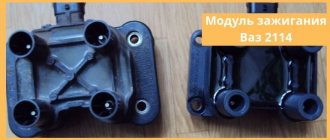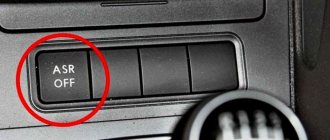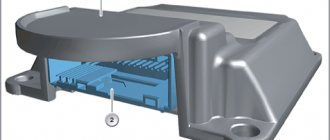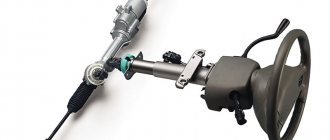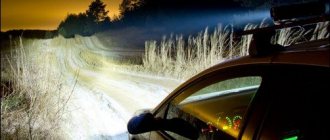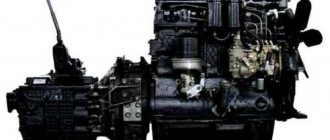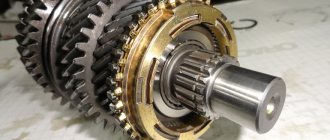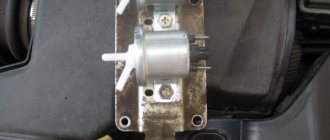- What do the different ranges mean?
- X
- K or kay
- Ka
- Ku
- L
- Other modes
- Which ones can be disabled and which ones can be enabled?
With the advent of rules limiting the speed of a car, a device appeared that began to record these violations - radar. However, action causes counteraction, that is, the appearance of devices such as radar detectors and radar detectors. Most car enthusiasts know the operating principle of these devices and their design. But the meaning of many symbols is unfamiliar to them, so not everyone can answer the question of what the kei range on the radar means.
What is a radar detector and its ranges
First you need to understand the terminology and understand the difference between a radar detector and a radar detector. Some people think they are the same thing. But this is a wrong conclusion.
A radar detector is a device that suppresses the frequencies to which it is tuned. Such an active device is prohibited by law, and its use may result in fines and confiscation.
But a radar detector is essentially a passive electronic device that only detects and warns the owner that he is in the area covered by traffic police radars. That is, a radar detector is an ordinary receiver that detects certain frequencies without suppressing or blocking them. It is not prohibited by law.
Most often, these automotive devices can operate in several radio frequency ranges (the radio frequency in which the emitter operates). There are several such ranges. To make it easier to perceive, they were designated by letters: X, K, Ku, Ka. There are also several very interesting additional modes.
What does Instant-On, POP mean?
The following features of police detectors are distinguished:
- Instant-ON. Thanks to this, the equipment turns on instantly. In this case, the radar is in standby mode and does not signal. Immediately after pressing a special button, the device is triggered and instantly begins measuring the speed of each target approaching it.
- POP is a technology responsible for the structure of the signal emitted by police radar. When the speed of a moving vehicle is measured, the device emits a small pulse. As a result, it is more difficult for radar detectors to determine the location of the speed measuring device. Many models consider this impulse to be a nuisance, so they do not signal the driver regarding approaching danger.
In order for the radar detector to recognize such a pulse, it must be equipped with a special additional function. Devices with security technology are more expensive.
Range X
The frequency that formed the basis of the first radars is called the X band. Its operating wave is 10525 MHz. The range bandwidth is 10.50-10.55 GHz. Based on this, radars for traffic police of the Barrier, Sokol, Sokol M (D, S) types were developed.
At the moment, X-frequency radars are becoming a thing of the past. The reason for this is the moral and technical aging of such gadgets. Many industrial and household appliances operate in the same range, which causes false alarms.
Radar complex "Cordon"
0 Piterskaya produces the Kordon radar system, which has an extremely wide viewing angle and is capable of monitoring up to four lanes of traffic. These complexes are installed on lighting masts at a height of up to 10 meters from the road or directly above the roadway. In addition to speed, Cordons can detect those who like to drive on the side of the road, on the oncoming lane, or in public transport lanes.
Key range
Newer devices already operate on the K-band (or “kei”). Its operating frequency is 24150 MHz. The bandwidth is 100 MHz, which means less interference.
Gadgets operating in the kei range have greater energy potential and a shorter period. Consequently, the device has an increased detection range of traffic police radars (one and a half times compared to the X range) and compact dimensions.
This range is the basic range almost all over the world. Radars such as Berkut, Iskra-1, as well as their modifications and versions with photo and video capabilities operate on its basis.
What does the kei band mean on radar? Nothing complicated, just a radar detector picked up a signal emitted by a traffic police officer’s radar, or a camera.
Stationary complex "Kris-S" on the left, mobile "Kris-P" on the right
0 Another radar speed meter from Simikon is the Chris system, produced in both stationary and mobile versions. The stationary Chris-S is mounted above the roadway and is capable of tracking only one lane of traffic. As can be seen in the figure, to control several lanes, it is necessary to install several units. "Chris-S" can detect speeding, driving into the oncoming lane and driving in the public transport lane. The capabilities of the mobile complex are limited: unlike a stationary one, it cannot detect oncoming traffic. Cameras for photo recording of violations measure speed based on the processing of video frames. The first frame is taken to capture the vehicle, then several more frames are recorded at a speed of 40 ms, from which the distance traveled is measured and the average speed of movement is calculated.
Ka band
This is a fairly new and very promising radio frequency range, which has a carrier frequency of 34.7 GHz. It began to be used in America in 1991. Now they are also used in Europe, but the CIS countries and Russia do not yet use it.
This range of the radar detector is characterized by an even greater energy potential and a shorter period. Thanks to this, the Ka-band has a detection range of 1.5 km, during which high accuracy and minimum wasted time are maintained.
This range is called “superwide”. All this is due to its large bandwidth - 1400 MHz.
Important! In Russia, some military and radio equipment can operate in Ka mode, which causes false signals.
Satellite communications [ edit | edit code]
One of the main applications of K-band is satellite communications. Due to the fact that there is no longer room left for these purposes in the traditional bands (S-, L-, C-, X- and Ku-), Ka- and K-bands are now being used more and more.
In satellite communications this range is called Ka-band 30/20 GHz
and the frequency bands reserved for these purposes lie between 18.3-18.8 and 19.7-20.2 GHz for the Satellite-Earth link, and between 27.5 and 31 GHz for the Earth-Satellite link. That is, the Satellite-Earth channel lies entirely in the K-band, and the Earth-Satellite channel lies entirely in the Ka-band [2] [3] [4].
Currently, among the systems using the Ka-band 30/20 GHz we can note the Canadian Anik F2, which has 45 active Ka-transponders and provides multimedia services and broadband Internet access in North America [5], as well as KA-SAT owned by Eutelsat and providing similar services throughout Europe [6]. Among Russian satellites, this range is used by the military satellites Raduga-1 and Raduga-1M. In addition, the planned Express AM4 satellite, launched into an off-design orbit in August 2011 and subsequently declared completely lost, was supposed to operate in this range.
Additional modes and functions
Laser range. The first time devices working with lasers began to be used to calculate speed was back in the 90s of the last century. The operating principle of the radar detector is very simple: several short signals are sent at equal intervals. After performing digital calculations, the device produces an average number. This principle essentially remains the same, but the distance and frequency of the signals have just changed. Currently, pulse lengths range from 800 nm to 1100 nm. All modern radar detectors are equipped with special sensors that detect laser pulses. The only “BUT” is that the device with the laser range can only work in dry weather.
VG2 or Specter mode. These modes are used in those regions where the use of radar detectors is prohibited by law. These are mainly European countries and some states in America. The bottom line is that the direction finder has an ultra-sensitive receiver, which picks up the signals from the radar detector. At the same time, with a high degree of probability, it indicates the location of the prohibited device. That is why the latest versions of good radar detectors have a built-in function to automatically turn off their local oscillator if a radar appears in its “field of view”, which operates in the VG2 range.
Important! In Russia, Belarus and Ukraine, some special equipment for receiving and transmitting communications operates in VG2 mode. Therefore, it is better to turn off this function when you are in these countries, so as not to cause false signals.
POP mode. There are radars that use only one pulse to measure speed. Its duration can be up to 1/15 of a second. That is, such radars measure speed very quickly - 1 second is enough. Typically, this mode is used in the Iskra type radar. If the radar detector is not equipped with POP mode, then it simply cannot identify it. The POP regime is an international standard that is followed by all world leaders.
Ultra-X and Ultra-K modes. These are modes presented by creators from China and Korea. In essence, this is the same POP, only “cut down” and without certification. The modes do not work correctly with pulses of the X and K ranges.
Hyper-X and Hyper-K modes. These are the newest closed complexes of the system. The essence of the work is a double heuristic analysis of received signals. The complexes have very high accuracy in detecting signals of any duration in modes such as X, K and NEW K (extended range).
SWS function. To use radar detectors in Russia, this function is not needed. At its core, SWS is a system that warns of danger. That is, when approaching an emergency area, the radar detector gives a warning signal.
Anti-sleep function. This option is designed specifically to check the driver's reaction after a certain period of time. The operating algorithm is as follows: the car radar emits a sound signal, and if the driver does not turn it off within the shortest period of time, the device begins to “sound the alarm.”
Complex for photographic recording of violations "Strelka-ST"
0 See all photos in the gallery
Radar cameras include one of the most widespread systems in Russia, “Strelka” (there are about 700 of them in Moscow alone). It was developed by the Russian company, which produces the complex in several modifications. “Strelka” can measure not only the speed of movement, but also record the passage of a prohibiting traffic light signal, as well as the intersection of a solid line. In this case, the camera does not necessarily hang on a mast, but can also be mobile, for example, standing on a tripod near the road. Recently, the use of so-called “cuckoos” - cameras that are equipped only with a radar, and instead of a lens, have a glass plug built into them, has become increasingly widespread. These complexes cost tens of times less and are capable of sending only a radar beam, which confuses the owners of radar detectors and somehow forces them to slow down. In fact, they do not record any data or violations. Previously, they could be distinguished from those working by the absence of a rather large iron box with equipment, which must necessarily be located nearby on a mast or somewhere else, but now the authorities began to make dummies of them.
Types of receivers. Their advantages and disadvantages
There are two types of radio signal receivers in automotive radar detectors: without conversion (direct type) and frequency discriminator (that is, with superheterodyne conversion).
The direct type receiver is the easiest (and also the oldest) method. Such a radar detector does not need to be hidden from special modes of traffic police radars. And all because the amplifier does not have any radiation. Another advantage of such a device is the almost complete absence of interference.
But all the advantages can also be called disadvantages. Despite their low cost, due to low sensitivity, devices of this type were abandoned in all countries except domestic manufacturers.
An amplifier based on a local oscillator or superheterodyne is considered more progressive and technologically advanced. It is used in radars of medium and high price categories. The main advantage of such devices is their high sensitivity and ability to filter out unnecessary signals from the incoming signal stream.
An important disadvantage of this amplifier is the ability to easily detect it by traffic police officers using special gadgets.
Parkwright complex for parking control
0 These devices are usually invisible to passers-by and car owners: they are installed in data center vehicles that control parking, and even in regular buses, where they are invisible to the drivers of these same buses. For example, in Moscow, Parkright devices running on the Windows operating system are responsible for monitoring parking space. They are united into a single network using GPRS modules, and in order to control payment for parking, they only need to photograph your car twice. Moreover, the first picture can be taken by one data center machine, and the second by another. The devices also have such additional functions as recognition of driving through a red traffic light, driving in a public transport lane, driving into oncoming traffic, and even searching for stolen vehicles.
Operating principle and installation location
The operating principle of the device is as follows: to measure speed, the traffic police radar receives a signal that is reflected from a moving car. The radar detector works “directly”, without reflection. Under ideal conditions (good terrain and weather), the radar detector can “see” at a distance of up to 5 km (but the traffic police radar is only 400 m).
Typically, a car radar is mounted on the windshield of a car using a small bracket. An important point here: you need to find a place where there are no heating or tinting strips, since this all affects signal reception. Power comes from the cigarette lighter or built-in battery.
What types of fixation are there?
Most often, traffic police fines come from cameras when violations are recorded on stationary cameras. These are installed on poles and other supporting structures at the sides of transport arteries and monitor roads around the clock.
Different complexes have different technical characteristics, “farsightedness,” maximum fixation speed and a list of types of violations that they are ready to track.
In addition to them, portable video recording systems are used that “read” only speeding. Along with them, mobile traffic police cameras can also be used - in 2022 they will be installed on patrol cars and public transport. They see not only violations of the speed limit, but also non-compliance with parking rules, passage of heavy equipment and a number of other traffic violations.
And in some regions, the police have even begun to use drones and balloons, but this is more of an experiment than a rule. Let's take a closer look at the main video recording systems.
Radar detectors Neoline
As a preface, it is necessary to say about such a “shock” as the use of a Strelka-type radar, which distinguished itself by measuring the speeds of all cars that fell within its coverage area. Panoramic view of video cameras and illumination up to 200 m are other advantages of this kit.
For a long time, radar detector developers did not know how to bypass Strelka. Devices with built-in GPS function came to the rescue, sending a signal when approaching the camera. But even such a device “caught” too much interference.
As a result, the Neoline company presented its invention - a radar detector that can detect Strelka at a distance of up to 800 m in urban conditions. Neoline radar detectors also operate in standard ranges - X, K, Ka, La (laser range). Some Neoline models have built-in GPS modules.
The company's developers are actively working to improve the operating algorithms of their devices and modernize the appearance of the gadgets.
Time-tested complexes
Strelka-CT
Perhaps the most common traffic police video camera on Russian roads is the Strelka ST. She can do the following:
- sees speed limit violators,
- controls traffic in the oncoming lane,
- on the side of the road,
- dedicated lane for public transport,
- crossing the stop line,
- movement of trucks in prohibited places and other violations.
The “vision range” of the camera exceeds 500 m. At this distance, it “catches” the violator in the traffic, “leads” him until he approaches a distance of 50 m, after which he records the violator and his license plate number using a camera. The downside of this system is that it does not respond to objects moving at speeds exceeding 180 km/h.
AvtoUragan-VSM2
This is not just a camera - it is a whole system that combines several photo-video recording complexes, which has a common time synchronization based on a signal from GLONASS/GPS. These traffic police cameras can record 17 types of traffic violations, including:
- over speed,
- driving on red,
- leaving the stop line,
- driving under a prohibiting sign,
- riding on tram tracks,
- sidewalks and bike paths.
The cameras see up to 4 road lanes, record objects at speeds of up to 255 km/h and provide accuracy with an error of no more than 2 km/h.
Odysseus
Autonomous stationary complex consisting of several cameras. It has 12 types of violations that it can capture, including:
- over speed,
- passing a prohibitory signal,
- driving into the oncoming lane,
- turning left or making a U-turn in violation of the markings,
- driving in the opposite direction on a one-way road, and so on.
The camera was created by TCOBDD LLC and reacts to objects moving at speeds of up to 250 km/h. The estimated error is ±1 km/h, the range of operation is classified by the manufacturer. In addition to recording traffic rules, the complex checks license plates for their presence in databases, for example, on the wanted list.
Krechet-SM, SKAT, SKAT-RIF, SKAT-PP
A series of cameras produced by Olvia LLC. Each of them has exceptional specific features. For example, KRECHET-SM provides continuous control with photo recording of all vehicles, SKAT can be used as a stationary or mobile fixing complex, SKAT-RIF works on the same principle as Avtodoriya, providing a mathematical calculation of the speed of movement.
And SKAT-PP is a traffic police camera designed to “catch” traffic violations in the pedestrian crossing area.
Krechet sees intruders in the range of 10-100 m, SKAT in the range of 5-50 m, and for SKAT-RIF such a range does not matter at all. Any of the systems recognizes violators if they move within 250 km/h.
Something else useful for you:
- Is it possible not to pay traffic fines and how?
- Is it possible to order and legally drive without a fine with license plates without the Russian flag?
- The traffic police inspector saw/filmed the violation, but didn’t stop it – what will happen?
Parkon-S
This complex is designed primarily to identify violators of stopping and parking rules. Parkon-S includes several PTZ street cameras controlled from a single center. Today you can find these funds on the maps of most Russian cities.
The system records cars parked in a given area and sends information about them to a single center: two photos with the date and time, license plate number, location and other information. Sees violators both on his own and on the opposite side of the road.
VOCORD Traffic
The VOCORD Traffic system is capable of recording 15 types of violations, including:
- speed limit violation;
- violation of intersection crossing rules;
- intersection of solid lines;
- violation of parking and stopping rules;
- violation in the pedestrian crossing area, etc.
The complex can include various components and measure speed using both detectors (up to 300 km/h) and optics (up to 250 km/h). The developers claim that the system is not recognized by radar detectors, provides 97% reliability of license plate recognition and passes less than 2% of total traffic.
Update and firmware
Sooner or later the question arises of how to update the radar detector. It is important to understand that this should only be done according to the operating instructions. The book will contain manufacturers' advice on this task, and should also describe the firmware version and instructions for reprogramming.
Important! Each manufacturer uses its own databases and updates. Therefore, the reprogramming process may differ depending on the device model. How to update a radar detector?
Algorithm for self-reprogramming:
- First of all, we remove the device and connect it to the computer using a cable (usually it comes included).
- Next, you should launch special software. It is important to choose exactly the one that matches the device model. It is necessary to familiarize yourself with the terms of use and consumer reviews in advance. Usually the update database and firmware versions are available on the manufacturer's website. But they can also be found on other sites.
- When everything is ready, the program will start. If all previous recommendations have been taken into account, the utility will begin automatic updating. After successful completion of the software, the device will again be available for full use.
APK "AvtoUragan-VSM"
Maximum vehicle fixation speed: 255 km/h.
Is this camera detected by radar : no.
Manufacturer's website: https://avtouragan.ru/.
Type of control: road traffic, traffic violations (including speed).
Is the camera currently in use: yes.
What is this camera: the AvtoUragan complex refers to stationary equipment that is designed to automatically read and record state license plates of vehicles on the road. The error in measuring the speed of this complex is only 2 km/h (both downward and upward).
The voice and silence of a car radar
It often happens that radar detectors start beeping at every corner. This is usually due to interference. This could be an oncoming car with the same gadget, or cameras at gas stations, or other reasons.
There are several tips to resolve the issue:
- The radar has an X band, which means interference that can be treated with a little suspicion. Alternatively, this range can be disabled, as it is rarely used.
- The range on the radar is “kei”, which means it’s better to play it safe and slow down.
- But if the radar is silent, but there is a traffic camera nearby, then most likely it is simply turned off, so the gadget did not react to it.
Traffic cameras in 2021. Principles of operation of photo-video recording cameras.
Yes, there is such a map in 2022. Under the auspices of crime prevention, instead of detection, the traffic police has released and maintains up-to-date an official map where you can see within the region and city where auto registration complexes are located.
The disadvantage of such a traffic police map is that it shows only stationary video cameras. Obviously, the portable tools will not be updated daily. But you won’t find these on other resources either - here only radar detectors can help.
View a map of traffic cameras in Russia on the official website of the State Traffic Safety Inspectorate.
To view the location of cameras, select your region in the drop-down list below the map and enlarge the map itself to find the road you need.
Photo radar is the easiest way to collect money
The next round in the war of radars and anti-radars is photo radar, which, if detected, you will only know about it after receiving a receipt for a fine. It has a low-power radar of one design or another to detect speed and photographs the car driving at excess speed (down to the license plates and the person behind the wheel). There's no point in arguing—the machine doesn't lie. Some photo radars are equipped with a rotation device that allows them to scan a specific area of the road, making them even more difficult to detect and reducing the likelihood of error. The radar that detects speed is very low-power, its range usually does not exceed 30-50m, which also makes it difficult to detect, especially if it is blocked by buildings or other cars.
Several types of such devices are used:
RADAR4
Is a radarless complex (such as Avtodoriya, etc.) a step forward compared to conventional microwave technology?
In technology there are almost no steps forward - mostly in a spiral. A hundred years ago, two hoses with water were placed across the road at a distance of several tens of meters, and a policeman with a stopwatch measured the time interval between the “fountains” when a car passed through the hoses. The next version implied two cameras at a distance of 1 km and a bunch of operators who determined the numbers of the “racers” by eye. And these days, “Avtodoria” has appeared: video cameras record the vehicle as it enters and exits the measured section of the road. Having calculated the travel time, the system displays the speed at which the car covered this distance. The system itself is not new: similar systems have been used for many years in a number of European countries. It can be used on highway sections from 500 m to 10 km.
Do license plates “sealed” with a special film save you from photo/video recording complexes? Smartphones do not see anything in these cases...
Detailed materials on this topic can be found here and here.
Let us briefly note that serious measuring systems use so-called machine vision cameras, and not household “telephone” toys. They record even the minimal difference between the background and the taped-on number. And recent developments make it possible to cope with more complex tasks, such as reading completely contaminated license plates. However, we will not disclose the technical features of such devices, so as not to provoke another “arms race” between guardians of the law and its violators.
Almost all police forces in the world (including traffic police) use radar to measure speed, enforce speed limits and replenish the treasury. Since the development of these devices, radar detectors have been relentlessly following them. Unfortunately, the police have two aces - they can choose the time and place for theirs (and increase their stopping power by choosing places, dangerous or not, where most normal people drive fast) and outlaw the most effective countermeasures, such as jamming and use of radar detectors.
The radar sends out a pulsed or continuous radio frequency signal and listens for the reflection of that signal. When a pulse reaches a moving object, its frequency changes in accordance with the speed and direction of movement (Doppler effect). New systems have also emerged that use laser radiation to determine speed.
There are three main frequency bands in which police radars operate, commonly referred to as X-band (11 GHz), K-band (24 GHz) and Ka-band (32-36 GHz). All radar detectors listen to these frequencies and beep, chirp and blink when they detect a signal. Increasing the sensitivity of the radar detector allows it to be detected by the radar earlier. Unfortunately, these frequencies are also used by various useful devices, such as automatic garage door openers, security systems, and are also present in the emissions of power lines. Hence the second side of the problem grows - anti-radars, which catch everything and more often lie than warn.
